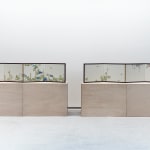Nishimura Goun (1877–1938)
Morning Glories
Color and gold on silk, pair of four-panel folding screens
Seals: Go; Goun
36 x 185 cm each (overall)
Further images
Folding screens come in various sizes. Small examples include table or waist-height screens around 100–150 cm high and screens placed around pillows to block the wind when sleeping. This adorable pair of four-panel folding screens is smaller than all of these. Nishimura Goun first studied traditional painting methods under Kishi Chikudo, a painter renowned for his depictions of tigers. After Chikudo passed away, Goun then became a pupil of Takeuchi Seiho, a representative contemporary Kyoto painter. Goun followed his own broad-ranging path as a painter, encouraged in part by Seiho’s liberal teaching style. Animals were a major theme of Goun’s Meiji-period works, as evinced by Frozen Night (1902, Adachi Museum of Art), Hungry Fox in Unmelted Snow (1903, Umi-Mori Art Museum), and White Bear (Roaring) (1907; this was based on sketches made at Kyoto City Zoo and it won third prize at the first Bunten exhibition). As such, people tend to assume he specialized in animal paintings, but his pictures actually covered many themes, including birds and flowers, people, and landscapes, with Goun developing his own aesthetic style based on scrupulous observations and superlative skills. His highly-developed powers of expression suggest he was more of an heir to Seiho’s aesthetic traditions than Seiho’s son-in-law Nishiyama Suisho, with his brushwork sometimes possessing a wit and sophistication that even surpassed his master. His talent was such that Seiho was deeply saddened by his pupil’s untimely death.
The present painting seems to evoke a hot summer day. We see some delightful morning glories performing their morning ritual of unfurling under the gentle morning light, just before the sun’s scorching rays hit the earth. Some tightly-wrapped buds will loosen up under the sun today, perhaps to bloom tomorrow. The morning glories, with all their intimations of summer mornings, are skillfully portrayed through a color contrast with garden balsams.
The left-hand screen presents a scene of criss-crossing straight lines, with a lateral frame cutting across the bamboo rising from the ground. Morning glory buds rise sinuously in between and a dragonfly flitters about freely. However, straight lines are largely eschewed on the right-hand screen in favor of gentle arcs and curves. As such, the two screens strike a curious contrast.
These small screens are not meant to be appreciated from a distance. Rather, the viewer is advised to kneel before the screens and observe them from touching distance. With the body and gaze centered on the paintings, perhaps the viewer will recall childhood memories of stooping down to pick morning glories before squeezing them in water to make colored water, for instance, or of launching garden balsam seeds into the air.
Nishimura Goun (nihonga painter; 1877–1938)
Nihonga painter, born in Kyoto. Goun studied with Kishi Chikudo and Takeuchi Seiho and followed stylistically in the tradition of his teachers. He earned a reputation for his bird-and-flower and animal paintings, and led the private painting school Shinchosha. Member of the Japan Art Academy and jury member of Teiten (Japan Art Academy Exhibition).
The present painting seems to evoke a hot summer day. We see some delightful morning glories performing their morning ritual of unfurling under the gentle morning light, just before the sun’s scorching rays hit the earth. Some tightly-wrapped buds will loosen up under the sun today, perhaps to bloom tomorrow. The morning glories, with all their intimations of summer mornings, are skillfully portrayed through a color contrast with garden balsams.
The left-hand screen presents a scene of criss-crossing straight lines, with a lateral frame cutting across the bamboo rising from the ground. Morning glory buds rise sinuously in between and a dragonfly flitters about freely. However, straight lines are largely eschewed on the right-hand screen in favor of gentle arcs and curves. As such, the two screens strike a curious contrast.
These small screens are not meant to be appreciated from a distance. Rather, the viewer is advised to kneel before the screens and observe them from touching distance. With the body and gaze centered on the paintings, perhaps the viewer will recall childhood memories of stooping down to pick morning glories before squeezing them in water to make colored water, for instance, or of launching garden balsam seeds into the air.
Nishimura Goun (nihonga painter; 1877–1938)
Nihonga painter, born in Kyoto. Goun studied with Kishi Chikudo and Takeuchi Seiho and followed stylistically in the tradition of his teachers. He earned a reputation for his bird-and-flower and animal paintings, and led the private painting school Shinchosha. Member of the Japan Art Academy and jury member of Teiten (Japan Art Academy Exhibition).









